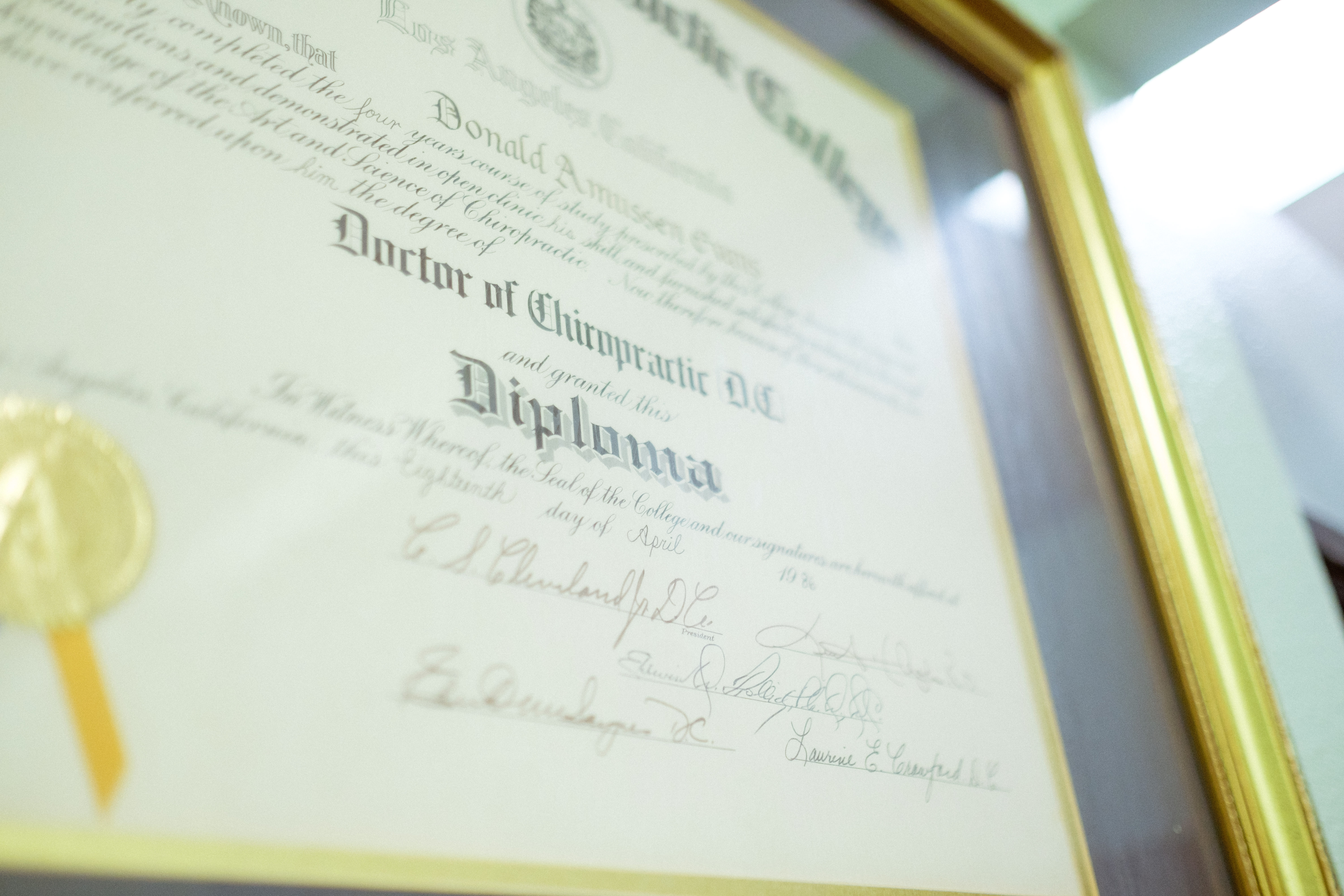Chiropractors are healthcare professionals who specialize in the diagnosis, treatment, and prevention of musculoskeletal disorders, especially thse affecting the spine. They use a range of non-invasive techniques, including spinal adjustments, manipulations, and massage, to help their patients achieve optimal health and wellness.
One of the most common questions that people have about chiropractors is whether or not they go to medical school. The answer is that while chiropractors do not attend traditional medical school, they do undergo extensive training and education to become licensed healthcare practitioners.
To become a chiropractor, you first need to complete at least three years of undergraduate study, although many students choose to complete a full bachelor’s degree before applying to chiropractic college. After completing your undergraduate coursework, you will then need to enroll in a Doctor of Chiropractic degree program, which typically takes between three and five years to complete.
During your chiropractic education, you will receive in-depth training in anatomy, physiology, pathology, neurology, radiology, and other foundational sciences. You will also learn a range of chiropractic techniques and therapies, including spinal adjustments, soft tissue therapies, and rehabilitative exercises.
While chiropractic education is not the same as that of medical doctors or osteopathic doctors, it is still highly rigorous and demanding. Chiropractic students typically complete over 4,200 hours of instructional coursework, including extensive clinical experience. This training prepares chiropractors to diagnose and treat a wide range of musculoskeletal conditions, ranging from back pain and neck pain to headaches, sciatica, and more.
In conclusion, while chiropractors do not attend traditional medical school, they do undergo extensive training and education to become licensed healthcare practitioners. If you are considering a career in chiropractic, you can expect to complete at least seven years of post-secondary education and training before becoming a licensed chiropractor. With a commitment to ongoing education and professional development, chiropractors can make a significant difference in the lives of their patients and communities.
Comparing Chiropractic School to Medical School
Chiropractic school and medical school have some similarities, but also some distinct differences. Both require a rigorous academic curriculum, including courses in anatomy, physiology, pathology, and clinical diagnosis. However, chiropractic school does not include a pharmacology component, meaning chiropractors do not prescribe medication or perform surgery. Additionally, chiropractic school may have a greater emphasis on hands-on techniques such as spinal manipulation and oter manual therapies. Medical school and chiropractic school both require extensive clinical experience, but the focus of that experience may differ somewhat. Ultimately, while there are similarities between the two programs, they are distinct educational paths leading to different professions.

Becoming a Chiropractor Without Medical School
Yes, it is possible to become a chiropractor without attending a traditional medical school and obtaining either an M.D. or D.O. degree. Chiropractic is a separate healthcare profession that focuses on the diagnosis, treatment, and prevention of musculoskeletal disorders, particularly those affecting the spine.
To become a chiropractor, one must complete a four-year Doctor of Chiropractic (D.C.) program at an accredited chiropractic college. These programs typically include coursework in anatomy, physiology, neurology, pathology, biomechanics, chiropractic technique, and patient management.
After completing the D.C. program, aspiring chiropractors must pass the National Board of Chiropractic Examiners (NBCE) exam and any state-specific licensing exams to become licensed to practice.
While chiropractors are not medical doctors, they are licensed healthcare professionals who can diagnose and treat a variety of musculoskeletal conditions. They may also work in conjunction with medical doctors and other healthcare providers to provide comprehensive care to patients.
How Long Does It Take to Become a Chiropractor?
A chiropractor typically completes a minimum of three years of undergraduate study before enrolling in a Doctor of Chiropractic degree program. This program can take anywhere from three and a half to five years to complete and requires a minimum of 4,200 instructional hours. Therefore, in total, a chiropractor can spend a minimum of six and a half years and up to eight years in medical school to become a licensed chiropractor.
Do Chiropractors Have More Schooling Than Doctors?
Chiropractors and medical doctors have different educational paths, but both require significant schooling. Chiropractic students complete nearly 4 years of undergraduate college coursework, which includes anatomy, physiology, biology, and chemistry, before attending a chiropractic college for 4 to 5 years. During this time, they receive extensive training in manual therapy techniques, spinal adjustments, and other non-invasive treatments for musculoskeletal conditions.
On the other hand, medical doctors typically complete 4 years of undergraduate college coursework folloed by 4 years of medical school. Their training includes a broad range of subjects, including anatomy, physiology, pharmacology, and pathology, as well as clinical rotations in various medical specialties. Medical doctors may also specialize in a particular area of medicine and complete additional years of training through residencies and fellowships.
So, in terms of total years of schooling, medical doctors may have a slightly longer educational path. However, both chiropractors and medical doctors undergo extensive training in their respective fields to provide quality care to their patients.
Is a Chiropractor a Medical Doctor or a Doctor of Philosophy?
A chiropractor is not an M.D. or a PHD. While they do hold a doctorate degree, it is a doctor of chiropractic degree (D.C.). This means that chiropractors are not medical doctors and do not have the same training as medical doctors. However, chiropractors do receive extensive training in chiropractic care and are licensed practitioners. To become a chiropractor, one must first obtain an undergraduate degree with a focus on the sciences before entering a chiropractic program. Upon completion of the program, chiropractors must pass a licensing exam in order to practice.

The Reason Behind Chiropractors Referring to Themselves as Doctors
Chiropractors are licensed healthcare professionals who are trained to diagnose and treat neuromuscular disorders, with a focus on the spine and the musculoskeletal system. They are called doctors because they hold a Doctor of Chiropractic (D.C.) degree, which is a professional degree awarded after completing a rigorous four-year program of study. This program includes coursework in anatomy, physiology, biochemistry, pathology, microbiology, radiology, and chiropractic technique. Additionally, chiropractors are required to complete a certain number of clinical hours and pass national board exams in order to becoe licensed to practice. While chiropractors are not medical doctors, they are authorized to diagnose and treat patients and are recognized as primary care providers in some states. As such, they are entitled to use the title of “Doctor” like other healthcare professionals who hold doctoral degrees.
Do Chiropractors Need to Take the MCAT?
No, chiropractors do not take the MCAT (Medical College Admission Test) before applying to chiropractic school. Instead, prospective chiropractors are typically required to complete at least three years (or 90 semester hours) of undergraduate education before applying to a chiropractic program. This undergraduate education should include courses in biology, chemistry, and physics, among others. Once accepted into chiropractic school, students will complete a four-year program that includes coursework in anatomy, physiology, pathology, and chiropractic techniques. After graduation, chiropractors must pass the National Board of Chiropractic Examiners exam in order to obtain a license to practice.
The Difficulty of Chiropractic School
Chiropractic school is a challenging and rigorous academic program that requires a significant amount of hard work, dedication, and discipline. The curriculum is designed to provide students with a comprehensive understanding of the human body and the musculoskeletal system, as well as the techniques and tools used to diagnose and treat vrious conditions.
One of the most difficult courses within the chiropractic degree program is biochemistry, which focuses on the chemical processes and reactions that occur within the body. This course requires a solid understanding of chemistry and biology, and often involves complex calculations and problem-solving skills.
Another challenging aspect of chiropractic school is the cadaver labs, which allow students to gain hands-on experience with human anatomy. These labs can be emotionally and physically demanding, as students must work with real human bodies and learn to navigate the complexities of the human body.
In addition, classes in nutrition and cardiovascular/pulmonary physiology can also be particularly challenging, as they require a deep understanding of the body’s systems and how they interact with each other.
Despite the difficulty of the program, many students find that the intense academic and practical training they receive in chiropractic school prepares them well for a rewarding career as a chiropractor.
The Difficulty of Studying to Become a Chiropractor
Studying to be a chiropractor can be challenging, as it involves intensive assessments, a high number of contact hours, and strict placement criteria to meet in order to graduate. The workload can be overwhelming, as there is a vast amount of information to learn and apply. Additionally, the placements can be tiring as they require meeting specific criteria, which can be physically and mentally demanding. However, with dedication, hard work, and a passion for the field, students can successfully complete their chiropractic studies and become well-prepared professionals in this rewarding healthcare field.

Comparing Chiropractic Care and Physical Therapy
Both chiropractors and physical therapists can be valuable in helping individuals recover from injuries and improve their mobility. However, the choice between the two depends on the specific neds of the individual.
Physical therapists specialize in helping individuals regain strength, flexibility, and mobility through exercises, stretches, and other forms of physical therapy. They work to improve overall physical function and often work with individuals who have suffered from injuries or illnesses that limit their mobility.
Chiropractors, on the other hand, focus on the musculoskeletal system, particularly the spine, to improve overall health and function. They use spinal adjustments and manipulations to relieve pain, reduce inflammation, and improve nerve function. Chiropractors often work with individuals who suffer from back pain, neck pain, and other musculoskeletal issues.
Both chiropractors and physical therapists can be effective in helping individuals recover from injuries and improve their overall mobility. However, the choice between the two depends on the specific needs of the individual. If an individual has an injury that limits their mobility, working with a physical therapist may be the best option. If the injury involves back pain or neck pain, then choosing a chiropractor may be the choice that helps them recover quickly. It’s important to consult with a healthcare professional to determine which option is best for you.
What Undergraduate Degree is Best for Becoming a Chiropractor?
If you are considering a career in chiropractic, there are several undergraduate degrees that can provide a solid foundation for your future studies. While there are many options available, three degrees in particular are often recommended for those pursuing a career in chiropractic.
The first degree that is often recommended is a degree in human biology. This degree provides students with a strong understanding of the human body and its functions, which is essential for anyone interested in pursuing a career in chiropractic. Human biology coursework typically includes classes in anatomy, physiology, and biochemistry, which are all important for understanding how the body works and how chiropractic treatments can be used to improve a patient’s overall health.
Another degree that is commonly recommended for pre-chiropractic students is a degree in kinesiology. Kinesiology is the study of human movement and physical activity, and it provides students with a deep understanding of how the body moves and functions. This degree is particularly useul for chiropractic students because it can help them understand how to improve a patient’s mobility and flexibility, which are often key components of chiropractic treatment.
Finally, a degree in exercise science is another great option for those interested in pursuing a career in chiropractic. This degree focuses on the science behind physical activity and exercise, and it can help students understand how to design exercise programs that can improve a patient’s overall health and well-being. As with the other degrees mentioned, exercise science coursework typically includes classes in anatomy, physiology, and biochemistry, which are all important for understanding the human body and how it works.
In conclusion, while there are many undergraduate degrees that can prepare students for a career in chiropractic, degrees in human biology, kinesiology, and exercise science are particularly well-suited for those interested in this field. By pursuing one of these degrees, students can gain a deep understanding of the human body and its functions, which will be essential for their future studies and their success as chiropractors.
The Benefits of Pursuing a Career in Chiropractic
Certainly! Chiropractic is a rewarding career that involves helping patients alleviate physical pain whie promoting overall wellness. Chiropractors use non-invasive techniques to help patients with musculoskeletal issues, including back pain, neck pain, headaches, and other related conditions. This career can be a great fit for those who enjoy problem-solving and have an interest in natural healthcare. Additionally, chiropractors can enjoy a flexible schedule and the ability to own their own practice. The job outlook for chiropractors is also positive, with a projected growth rate of 4% from 2019-2029 according to the Bureau of Labor Statistics. Overall, chiropractic is a fulfilling career choice for those who are passionate about helping others and promoting health and wellness.
What Profession is Higher than a Chiropractor?
It is not accurate to say that anything is necessarily “higher” than a chiropractor, as chiropractic is a distinct and valuable field of healthcare in its own right. However, there are other healthcare professionals who may work in complementary or related fields. For example, a medical doctor (MD) is a licensed physician who has completed medical school and a residency program, and is able to diagnose and treat a wide range of medical conditions. A doctor of osteopathy (DO) is a licensed physician who has completed a similar education and training program, but with a focus on osteopathic manipulative treatment (OMT) in addition to traditional medical treatments. Physical therapists (PTs) are healthcare professionals who specialize in the evaluation and treatment of movement dysfunction, often through exercise and manual therapy techniques. While these professionals may work collaboratively with chiropractors in cetain cases, they each have their own unique areas of expertise and focus within the broader field of healthcare.

Where Are the Highest Paying Jobs for Chiropractors?
Chiropractors can earn varying salaries depending on the industry they work in and the location of their practice. According to data from the Bureau of Labor Statistics (BLS), chiropractors earn the most in hospitals, physician’s offices and outpatient care centers. These industries offer higher salaries due to the demand for chiropractic services in medical settings. Additionally, the metropolitan areas with the highest average chiropractor salaries are Hartford, New York and Las Vegas. This is likely due to a combination of factors such as higher demand for chiropractic services in these areas, higher cost of living, and greater competition amog chiropractic practices. Overall, chiropractors can earn a comfortable living in many different settings, but those working in hospitals, physician’s offices and outpatient care centers may earn the highest salaries.
Comparing the Difficulty of Chiropractic School and Medical School
It is difficult to make a direct comparison between chiropractic school and medical school in terms of difficulty. Both are rigorous programs that require a significant amount of time, dedication, and hard work. However, there are some key differences between the two programs.
One major difference is the length of the programs. Chiropractic school typically takes four years to complete, wile medical school takes at least four years, followed by several years of residency training. This means that chiropractic students may have a shorter overall program length, but they may also have less time to learn and master the material.
Another difference is the scope of practice. Medical doctors are trained to diagnose and treat a wide range of medical conditions, while chiropractors focus primarily on the musculoskeletal system and the nervous system. This means that the coursework and clinical training in chiropractic school may be more focused on these areas, while medical school covers a broader range of topics.
In terms of admission requirements, both programs have high standards, but medical school tends to be more competitive overall. Medical schools typically require higher GPAs and test scores, as well as more extensive clinical experience and research experience.
Overall, it is difficult to say whether chiropractic school is easier than medical school, as both programs require a significant amount of hard work and dedication. Ultimately, the best choice will depend on an individual’s interests, career goals, and personal strengths.
Conclusion
In conclusion, chiropractors play an important role in the healthcare industry by providing non-invasive and drug-free treatments for musculoskeletal conditions. While they do not have a pharmacology component in their education, chiropractors receive extensive training in anatomy, physiology, and chiropractic techniques. They also undergo rigorous coursework and clinical practice to earn their Doctor of Chiropractic degree. With their specialized knowledge and skills, chiropractors are able to help patients alleviate pain, improve mobility, and enhance overall well-being. As such, chiropractic care is a valuable option for individuals seeking alternative or complementary treatments to traditional medical interventions.
